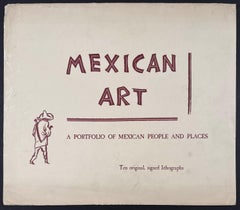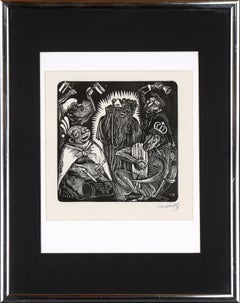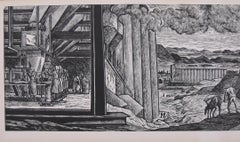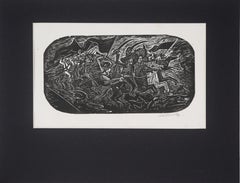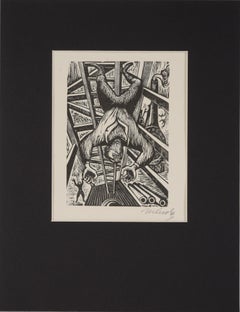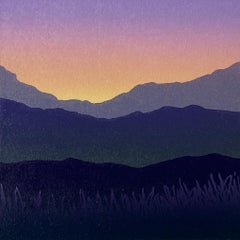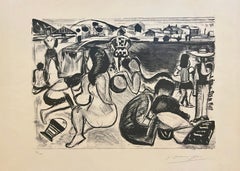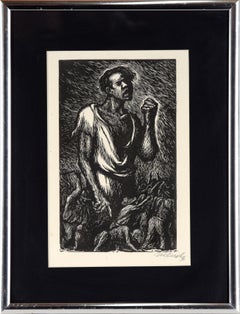Leopoldo Méndez Art
Mexican, 1902-1969
nullto
1
4
1
Overall Width
to
Overall Height
to
5
1
3
1
1
1
3
2
5
3
3
1
1
1
1
1
3
3
3
2
2
5
9,475
2,687
1,375
1,358
2
5
Artist: Leopoldo Méndez
Mexican Art: A Portfolio of Mexican People and Places
By Leopoldo Méndez
Located in Palm Springs, CA
Ten lithographs in excellent condition, with portfolio cover. The ten artists included in the 1946 portfolio "Mexican Art: A Portfolio of Mexican People and Places" include: Ángel Bracho / Francisco Mora / Fernando Castro Pacheco / Raúl Anguiano / Alberto Beltrán...
Category
1940s Leopoldo Méndez Art
Materials
Lithograph
$3,000 Sale Price
33% Off
God and the Four Evangelists ("Fool's Concert") - 1943 Linocut on Paper
By Leopoldo Méndez
Located in Soquel, CA
God and the Four Evangelists ("Fool's Concert") - 1943 Linocut on Paper
Leopoldo Méndez (Mexico City, Mexico, 1902–1969) "Fool's Concert" (from the portfolio "25 Prints of Leopoldo ...
Category
1940s Symbolist Leopoldo Méndez Art
Materials
Linocut, Printer's Ink, Laid Paper
THE MAKING OF TORTILLAS - Mural Size 47 1/2 inches Long
By Leopoldo Méndez
Located in Santa Monica, CA
LEOPOLDO MENDEZ (1902 – 1969)
THE MAKING OF TORTILLAS 1954
Linocut. Edition unknown. This example signed in pencil and dated 1957. 14” x 47 3/8” ...
Category
1950s Modern Leopoldo Méndez Art
Materials
Linocut
"Charge of the Revolutionist Cavalry" - 1931 Woodcut On Paper
By Leopoldo Méndez
Located in Soquel, CA
"Charge of the Revolutionist Cavalry" - 1931 Woodcut On Paper
1931 Black and white woodcut print titled "Charge of the Revolutionist Cavalry" by Leo...
Category
1930s Contemporary Leopoldo Méndez Art
Materials
India Ink, Laid Paper, Woodcut
"Accidente" - 1943 Linocut on Paper
By Leopoldo Méndez
Located in Soquel, CA
"Accidente" - 1943 Linocut on Paper
"Accidente" from the portfolio "25 Prints of Leopoldo Méndez", depicts a figure, upside down, appearing to fall downward from a ladder. Another f...
Category
1940s Post-Modern Leopoldo Méndez Art
Materials
Paper, India Ink, Linocut
Related Items
Moor - Handmade Linocut, Limited Edition Print Unique 2/8, Mountains
By Aneta Szoltis-Mencina
Located in Salzburg, AT
The artwork will be sent unframed, with passpartou
Linocut „Moor” 2023
Linocut print technique
Art print from 5 matrices
Limited edition, print unique number 2/8
Paper Fabriano Ros...
Category
2010s Contemporary Leopoldo Méndez Art
Materials
Paper, Linocut
$132 Sale Price
20% Off
H 7.88 in W 7.88 in
Untitled abstract seaside, original lithograph
By François Desnoyer
Located in Belgrade, MT
Pencil signed black and white lithograph original limited edition pencil signed , Guilde De La Gravure. Mid 20th Century, part of my private collection. Very Good condition.
Category
Mid-20th Century Cubist Leopoldo Méndez Art
Materials
Lithograph
$636 Sale Price
33% Off
H 13 in W 15 in
Tolosa (Toulouse); Leaf LXXI from Hartmann Schedel's Nuremberg Chronicle
Located in Middletown, NY
Woodcut on laid paper, 8 3/8 x 9 1/8 inches (212 x 233 mm), the full sheet. In excellent condition with text and portraits of Empedocles, Sapho, Zeuxis and others on the verso, as is...
Category
15th Century and Earlier Old Masters Leopoldo Méndez Art
Materials
Ink, Handmade Paper, Laid Paper, Woodcut
Prodigal Son
By Thomas Hart Benton
Located in London, GB
A man raises his hand to his chin, his neck tilted and face turned to look at a dilapidated farmhouse, barely held together by planks of wood and exposed to the elements. Behind him ...
Category
1930s American Modern Leopoldo Méndez Art
Materials
Lithograph
Clemente Untitled B: surreal mythical landscape, voyage with ocean, Venus, snake
By Francesco Clemente
Located in New York, NY
A black and white, large-scale surreal mythical landscape of an ocean voyage, with a snake wrapped around a clock, a ship, Venus sculpture, greek urns, and snakes, printed in black o...
Category
1980s Contemporary Leopoldo Méndez Art
Materials
Lithograph
$2,975
H 26.75 in W 119.25 in
"I Love You" Limited Edition towel/wall hanging (LARGE: 60 inches x 70 inches)
By Tracey Emin
Located in New York, NY
Tracey Emin
I Love You/I Love Your Soul/I Love Your Smile, ca. 2010
100% Cotton Beach Towel
60 × 70 inches (folded it's 25 x 30 inches)
Signed in plate, authorized printed...
Category
2010s Contemporary Leopoldo Méndez Art
Materials
Cotton, Screen, Mixed Media, Laid Paper
$2,800
H 60 in W 70 in D 0.3 in
“Thebes, Great Hall at Karnak”
By David Roberts
Located in San Francisco, CA
This lithograph titled "Thebes, Great Hall at Karnak" is a notable work by the Scottish painter David Roberts (1796-1864). This particular scene is part of Roberts' most famous colle...
Category
1840s English School Leopoldo Méndez Art
Materials
Paper, Lithograph
Down the River
By Thomas Hart Benton
Located in London, GB
In this sentimental work from 1939, Benton expresses his admiration for the rural lifestyle of the Midwest. He highlights the connection between man and the land by depicting two fig...
Category
1930s American Modern Leopoldo Méndez Art
Materials
Lithograph
“Winter” from the “Four Seasons Suite” Series
By Alvar Sunol Munoz-Ramos
Located in San Francisco, CA
This embossed, numbered and signed lithograph, part of the “Four Seasons Suite,” is by Alvar Suñol Muñoz-Ramos (b. 1935), a renowned Spanish ar...
Category
1970s Modern Leopoldo Méndez Art
Materials
Paper, Lithograph
$1,350
H 37.25 in W 30.5 in D 2 in
The Triumph of Caesar: Plate IV
By Andrea Mantegna
Located in Middletown, NY
Andreani, Andrea (Italian, about 1558–1610), after Andrea Mantegna (Italian, 1431-1506)
Chiaroscuro woodcut in colors printed from four blocks on laid paper in dark brown, grey, and...
Category
16th Century Old Masters Leopoldo Méndez Art
Materials
Ink, Handmade Paper, Laid Paper, Woodcut
The Triumph of Caesar: Plate IV of IX
By Andrea Mantegna
Located in Middletown, NY
Andreani, Andrea, after Andrea Mantegna
The Triumph of Caesar: Plate IV of IX
1599. Chiaroscuro woodcut in colors printed from four blocks on laid paper in dark brown, grey, and thr...
Category
16th Century Old Masters Leopoldo Méndez Art
Materials
Handmade Paper, Laid Paper, Ink, Woodcut
Vintage David Hockney Poster Miami New World Festival of Arts 1982 palm trees
By David Hockney
Located in New York, NY
This vintage David Hockney poster features whimsical imagery and rich, bright color. Palm trees, boats in the ocean, a cafe, and a bodega with an elaborate iron-wrought balcony sit a...
Category
1980s Realist Leopoldo Méndez Art
Materials
Lithograph
Previously Available Items
"La Protesta" - 1943 Linocut on Paper
By Leopoldo Méndez
Located in Soquel, CA
"La Protesta" - 1943 Linocut on Paper
"La Protesta" (from the portfolio "25 Prints of Leopoldo Méndez") shows the struggle of the working class in Mexico during the 1930s and 1940s....
Category
1940s Modern Leopoldo Méndez Art
Materials
India Ink, Paper, Linocut
Leopoldo Méndez art for sale on 1stDibs.
Find a wide variety of authentic Leopoldo Méndez art available for sale on 1stDibs. You can also browse by medium to find art by Leopoldo Méndez in linocut and more. Much of the original work by this artist or collective was created during the 1950s and is mostly associated with the modern style. Not every interior allows for large Leopoldo Méndez art, so small editions measuring 48 inches across are available. Leopoldo Méndez art prices can differ depending upon medium, time period and other attributes. On 1stDibs, the price for these items starts at $5,250 and tops out at $5,250, while the average work can sell for $5,250.
